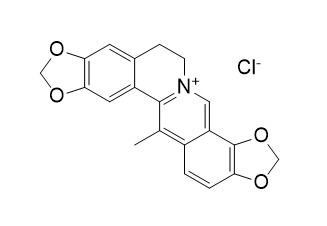Corysamine chloride
Corysamine chloride was identified to be active as the inhibitors of ACHE.
Inquire / Order:
manager@chemfaces.com
Technical Inquiries:
service@chemfaces.com
Tel:
+86-27-84237783
Fax:
+86-27-84254680
Address:
1 Building, No. 83, CheCheng Rd., Wuhan Economic and Technological Development Zone, Wuhan, Hubei 430056, PRC
Providing storage is as stated on the product vial and the vial is kept tightly sealed, the product can be stored for up to
24 months(2-8C).
Wherever possible, you should prepare and use solutions on the same day. However, if you need to make up stock solutions in advance, we recommend that you store the solution as aliquots in tightly sealed vials at -20C. Generally, these will be useable for up to two weeks. Before use, and prior to opening the vial we recommend that you allow your product to equilibrate to room temperature for at least 1 hour.
Need more advice on solubility, usage and handling? Please email to: service@chemfaces.com
The packaging of the product may have turned upside down during transportation, resulting in the natural compounds adhering to the neck or cap of the vial. take the vial out of its packaging and gently shake to let the compounds fall to the bottom of the vial. for liquid products, centrifuge at 200-500 RPM to gather the liquid at the bottom of the vial. try to avoid loss or contamination during handling.
Horticulture Research2022, uhac276.
Molecules.2023, 28(9):3685.
Plant Physiol Biochem.2021, 160:166-174.
Drug Des Devel Ther.2023, 17:2461-2479.
Processes2021, 9(5),831.
Antioxidants (Basel).2020, 9(7):581.
Biol Pharm Bull.2018, 41(1):65-72
Horticulturae2024, 10(4), 382.
Neurotox Res.2022, 40(6):1937-1947.
Journal of Life Science2017, 233-240
Related and Featured Products
Se Pu . 2013 Jul;31(7):640-5.
Screening of the active ingredients in natural products by capillary electrophoresis and high performance liquid chromatography-mass spectrometry[Pubmed:
24164032]
A new strategy for screening the crude natural extracts and quickly identifying the bioactive compounds was developed. In combination with high performance liquid chromatography-mass spectrometry (HPLC-MS) , the biologically active compounds, such as the enzyme i n the crude natural extract ca n be quickly identified by capillary electrophoresis (CE) -based activity assay. The crude natural extracts were assayed by a CE-based enzyme inhibitor screening method, and the active extract was isolated by HPLC-MS/MS with a semipreparative column. Then, each eluted component was assayed again with the CE-based assay method. Finally, the structures of the identified active compounds were elucidated by MS/MS analysis. Acetylcholinesterase ( ACHE), its substrate acetylthiocholine chloride ( AThCh), as well as the crude extract of Rhizoma coptidis were utilized for the proof of the methodology. Seven isoquinoline alkaloids, namely jatrorrhizine, epiberberine, columbamine, coptisine, corysamine, palmatine and berberine were identified to be active as the inhibitors of ACHE. Their IC50 values were 40, 442, 38, 182, 419, 54 and 16 micromol/L, respectively. Compared with the traditional screening methods, the method is characterized with several advantages, such as extremely low sample and reagent consumption, high speed of analysis, high sensitivity of detection, high throughput in terms of preparation of the natural products by HPLC. Overall, the results demonstrate that the method is valuable for the screening of the bioactive compounds in the crude natural extracts.
J Enzyme Inhib . 1985;1(1):35-46.
Interaction of yeast alcohol dehydrogenase with protoberberine alkaloids[Pubmed:
3916911]
Oxidation of ethanol and reduction of aldehyde catalysed by yeast alcohol dehydrogenase is inhibited by several naturally occurring as well as semi-synthetic protoberberine alkaloids. The affinity of these compounds for the enzyme depends essentially on their hydrophobicity. Corysamine and coptisine are the most potent inhibitors among the natural alkaloids of this group. The kinetics of yeast alcohol dehydrogenase inhibition with coptisine were analysed and equilibrium measurements using optical methods were carried out. The results suggest that the binding site of the enzyme for protoberberines is not identical with those for coenzyme and substrate though it should be located near the nicotinamide ring of bound NAD. The binding of protoberberines seems to be limited to rather superficially located hydrophobic groups in the vicinity of the active site of the enzyme. The inability of these alkaloids to protrude deeply into the molecule of yeast alcohol dehydrogenase at the catalytically important region is the main difference in their behaviour towards alcohol dehydrogenases from yeast and horse liver.
J Pharm Sci . 1976 Feb;65(2):294-6
Isolation and chemistry of alkaloids from plants of the family Papaveraceae LXVII: Corydalis cava (L.) Sch. et K. (C. tuberosa DC)[Pubmed:
1255467]
From Corydalis cava (L.) Sch. et K. (C. tuberosa DC) (Papaveraceae: genus Corydalis Med.), a mixture of alkaloids (0.53%) was isolated. The main alkaloid was (+)-bulbocapnine, and the minor alkaloids were coptisine, (+)-domestine, adlumidiceine, (+)-predicentrine, protopine, (-)-capnoidine, (+)-stylopine, (+)-isoboldine, 8-oxocoptisine, 1,2-methylenedioxy-6a,7-dehydroaporphine-10,11-quinone, and corysamine. In addition, fumaric acid was obtained. Coptisine, adlumidiceine, predicentrine, 8-oxocoptisine, corysamine, 1,2-methylenedioxy-6a, 7-dehydroaporphine-10,11-quinone, and isoboldine were found in C. cava for the first time, but rhoeadine and papaverrubine alkaloids were not detected. Predicentrine and isoboldine were identified on the basis of the UV, IR, mass, and PMR spectra.



